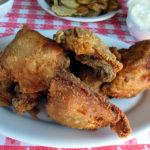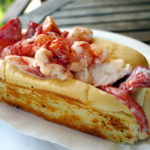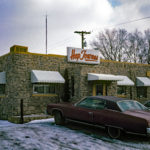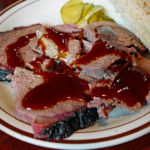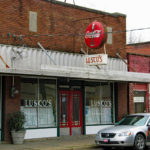Threadgill’s
“A lot of good stuff started in 1933,” said Texas governor Ann Richards on the occasion of her sixtieth birthday last year. At her party in Austin, which Richards used as the opportunity to begin her reelection campaign, the entertainment included singer and fellow Texan Willie Nelson, who happened to be born the same year as she. But Richards didn’t only mean Willie and herself; she was also referring to a third presence at the birthday party, sixty years old too and pure quill Texan: Treadgill’s roadhouse. Treadgill’s got its beer license in 1933, and now it is as much an icon of the Lone Star States as are the governor and Willie.
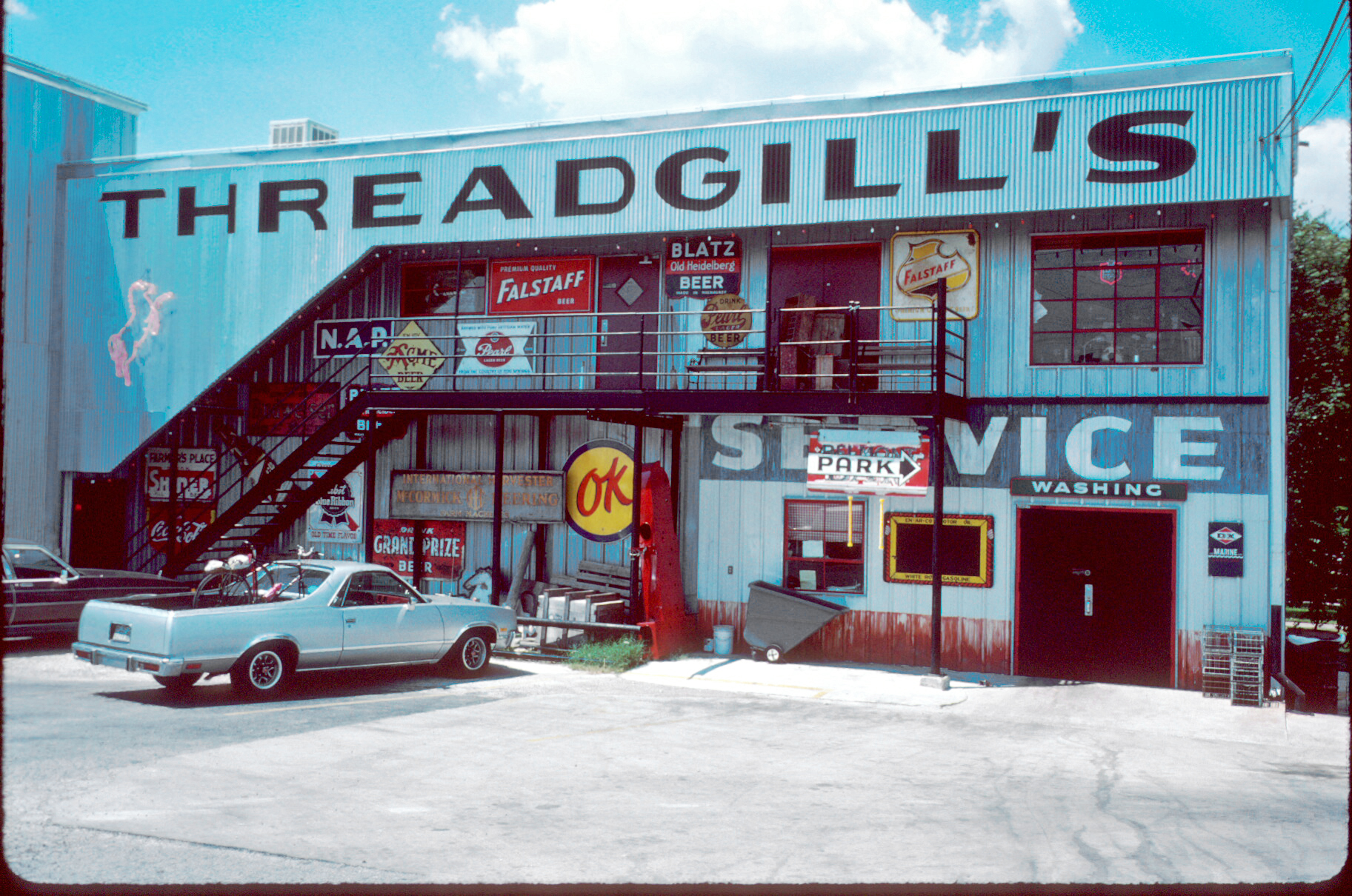
By Jane and Michael Stern
Orginally Published in 1994 Gourmet Magazine
“A lot of good stuff started in 1933,” said Texas governor Ann Richards on the occasion of her sixtieth birthday last year. At her party in Austin, which Richards used as the opportunity to begin her reelection campaign, the entertainment included singer and fellow Texan Willie Nelson, who happened to be born the same year as she. But Richards didn’t only mean Willie and herself; she was also referring to a third presence at the birthday party, sixty years old too and pure quill Texan: Treadgill’s roadhouse. Treadgill’s got its beer license in 1933, and now it is as much an icon of the Lone Star States as are the governor and Willie.
Ann Richards is a steady customer of Treadgill’s. which was invited to her birthday bash as a caterer- but not to feed the several hundred paying guests, who had each donated as much as ten thousand dollars to chat with her. The fat cats stood under a big tent eating lovely tea sandwiches, salmon mousse on crackers, sophisticated Southwestern tapas, and dainty chicken “drumettes,” all supplied by some of the capital city’s swankiest caterers. Threadgill’s food was set out only backstage, on a buffet reserved strictly for the production crew of some fifty stagehands, security guards, and musicians. However, not long after the festivities began, word leaked out among the swells, and pretty soon members of the denim-clad crew were joined in the chow line by clean-fingernail gents in 100X-beaver Stetsons and big-haired ladies in diamonds and pearls who had used their connections to wangle a way backstage and eat some of the two-fisted rations Threadgill’s had brought.
“There seems to be a magnetic force field around our food,” observed the proprietor of Threadgill’s, Eddie Wilson, a swamp-voiced, Mississippi-born Texan who was nattily—and uncharacteristically—outfitted in a black Ultrasuede jacket for the occasion. (“My dress code,” he proclaimed, pulling at the collar of his shirt in the 98-degree and painfully humid September weather, “is jeans; if it’s too hot for jeans, I cut them off.”) Wilson watched hankering locals sneak in for a taste of his seafood jambalaya, San Antonio squash, spinach casserole, yeast rolls, and Texas caviar (black-eyed peas marinated in vinaigrette with red onions and peppers), and he said, “Wherever we go, if we are catering an event with any kind of free access, we always bring two to three times more food than is required for the number of people expected. I don’t know how it happens, but there are always more mouths to feed than anybody anticipates. And I don’t like to see people hungry.”
One thing is certain: No one who eats a full meal at Threadgill’s, up at the north end of Austin, could possibly complain about being hungry. Not for days. Portions of everything are gargantuan. Corn bread squares overlap the plate on which they are presented. Meat loaf is sliced into massive slabs and smothered with chunky Creole sauce. Sheaves of smoked and glazed ham are covered by a great spill of Jezebel sauce (named for its sweet and tart blend of horseradish, mustard, apple jelly and pineapple preserves). And the deep-fried chicken liver platter is one of the most astounding plates of food available any-where, described on the menu as “more than anyone can eat!”
The dish is a mountain bigger than half a basketball of golden-crusted livers, perhaps two or three dozen of them, so gnarled and knobby you can almost see them puffing up and exploding when they hit the hot fat just a few minutes before. The plate itself is oversized, so it also has room for mashed potatoes, maybe a couple of cups worth, blanketed with thick, peppery cream gravy. On the side: more gravy in a wide bowl, suitable for dipping. Eddie Wilson gleefully tells how one day a friend of his, a customer and also a cardiologist, gaped at the chicken liver platter coming from the kitchen and declared that its cholesterol count exceeded the maximum recommended monthly dose for any human being.
Big as they are, though, portions of most things at Threadgill’s are considerably smaller than they used to be. Eddie explains, “My accountants sat me down and said this place was going to go down the tubes unless I raised my prices or cut the amount of food we served. I hated to do either, so I thought about it long and hard. The solution came when I heard my mama’s voice calling to me out of the past. She was saying, ‘Second helpings?’ And I knew what to do. I had to beat the kitchen staff with blunt instruments to get them to change their ways and dish out smaller portions of all our side dishes, but they learned to do it. And now when the waitress carries food to the table she tells everyone that second helpings are free. Only five to six percent of our customers have enough appetite for seconds, but they are happy to be asked, and they are so pleased with the waitress for asking that tips have gone way up. Everybody’s happy, even my accountants.”
Not all the Texas-sized helpings of food Threadgill’s serves are as nutritionally wicked as the chicken liver platter. The specialty of the house is vegetables; and, although many of them are cooked Southern-style (profusely enriched with cheese and butter and bread crumbs), several might please even a fastidious dieter. In the summer, when the weather has been right for growing, sliced tomatoes from Eddie and his wife Sandra’s garden are available: big, plump, flavorful beefsteaks of a quality that is hard enough to find in any pricey epicurean grocery store, let alone a roadside restaurant where the average meal check is well under ten dollars. Crunchy okra is stewed with snapping-fresh tomatoes. Black-eyed peas are scented merely with onion and garlic. Vegetarian jambalaya is a luscious mix of yellow rice, bits of hot jalapeno, cauliflower, tomatoes, squash, and bell peppers. Creole cabbage is simmered in a zesty sauce made from tomatoes smoked in Threadgill’s kitchen.
Our own preference on the vegetable roster is garlic cheese grits. Custard-textured, with only a muted garlic punch, this is supreme Southern nursery food. San Antonio squash, available only on Sundays, Mondays, and Tuesdays, is another comfortable classic. It is a sumptuous baked casserole of yellow squash, mild cheese, chili peppers, onions, and bread crumbs. Also on the Seriously Luscious List is spinach casserole (now served seven days a week), in which the limp green leaves are sodden with melted Swiss cheese and flavored with chunks of mushroom, bits of onion, lemon, and bacon.
“Victory with Vegetables” reads one side of the menu, where the twenty-three different side dishes Threadgill’s offers every day are listed: among them, ham-flavored butter beans, chili beans, broccoli and rice casserole, bacony turnip greens. Many customers come only to eat side dishes, and lots of them—a selection of three, five, or nine, all except the likker-soaked greens (which get their own bowl) heaped together on a single oval trencher like great colorful gobs of paint on the palette of an exuberant artist. “Someone once calculated that there were 15,553 different combinations available,” Eddie Wilson gloats. All Threadgill’s meals are accompanied by bread—a stack of it, oven-hot and heaped on a plate, usually including crumbly, moist squares of yellow corn bread, fragile white rolls redolent of the yeast that puffed them high only moments earlier, round-topped biscuits with a seductive buttermilk tang, corn-bread muffins laced with bits of jalapeno, and chunks cleaved from loaves of honey oat and whole wheat. Three of the exemplary vegetables and a pile of bread sells for $3.95.(1994) It’s got to be one of the best-tasting bargains anywhere in this land.
Good as the vegetables may be, it would be a big mistake to come to Threadgill’s and not eat meat, too —preferably something chicken-fried, meaning dipped in an egg wash, breaded, and cooked quickly in a vat of hot oil. The menu lists a chicken-fried pork chop and chicken-fried chicken breast, but the item you want to zero in on is the Southwestern paradigm: chicken-fried steak. It is sublime, a broad, irregularly shaped slab with a golden crust that’s all puckered and puffed. This is ambrosial crust, audibly crisp when you crunch down on a piece, yet melt-in-the-mouth rich. Encased within is serious beef with real flavor. Not filet mignon, mind you, nor sirloin nor top round. No indeed. This is a lowly cube steak, a cut with enough oomph to survive the arduous process of chicken-frying and still come out tasting like meat. It has been tenderized to within an inch of its life (the classic ranch-kitchen way is to drub the fight out of it with a sturdy piece of crockery or an old-fashioned 6 1/2-ounce Coke bottle) and with only a small amount of effort you can ease through it with a dull knife.
Once you’ve speared a bite-size piece of Threadgill’s chicken-fried steak on the tines of a fork, the fun begins. Push it through some gravy. Oh, what gravy! Thick, creamy, pepper-flecked, rich with the taste of beef stock, it is roadhouse pabulum of primal goodness. It comes atop the steak unless you specify you want it on the side, in a bowl. (Some people like to keep their crust at maximum crispness until the very moment they fork up a piece to eat, dipping only then.)
The other thing you need to have on that plate is mashed potatoes. It would be inconceivable to eat chicken-fried steak without them, and Threadgill’s mashes about seven hundred pounds per day. These are beauties: whipped smooth with plenty of butter and milk, thick and deeply potato-flavored, and improved even more by a mantle of that good gravy. Complete the picture with black-eyed peas, either hot or in the form of a cool salad, a steaming biscuit from the bread plate, a tumbler of iced tea, and maybe a wedge of cool buttermilk pie for dessert, and you have the quintessential Southwestern blue-plate feast.
Threadgill’s food is unforgettable, and the place itself is fantastic. Even if it didn’t serve the best square meals in Texas, it would be a landmark for the way it looks inside and the way it feels to eat here. A lot like Willie Nelson—and maybe even like Governor Richards—in character, Threadgill’s is somewhere on the outskirts of propriety and country to the bone. Eddie Wilson delights in its rowdy reputation.
“We’ve had the damnedest time trying to figure out what wine goes best with butter beans,” he jokes. Of course, you don’t want wine to drink with butter beans and chicken-fried steak. You want iced tea or lemonade or maybe buttermilk, all of which are on the menu, or you want beer, which is the decorative theme of Threadgill’s interior. There are neon beer signs throughout—for all the familiar national brands as well as for Billy Beer (named for Jimmy Carter’s late brother), Lone Star, Bluebonnet Ale, and Shiner Texas Special. Even before becoming a legal saloon in 1933 (with the first post-Prohibition beer license in Travis County), Threadgill’s was known for the dime-a-bottle homebrew suds it served, and long into the thirties it was still famous for its moonshine.
The man who started it all was Kenneth Threadgill, who got that beer license in December, 1933, and operated his place as a gas station and a tavern with live music every Wednesday night. Mr. Threadgill pumped gas, poured beer, and on Wednesdays he got on stage and yodeled and sang. He started performing on his own, jammed with musicians who happened by, then later formed a band called the Hootenanny Hoots. With his long white hair, love of the country sound, and talent for spinning yarns, Kenneth Threadgill became a well-known figure in the capital—a folklorist and a living piece of folklore all in one. When he died at age seventy-eight in 1987, obituaries described him as the patriarch of the Austin music scene.
Although Kenneth Threadgill’s original beer joint suffered a bad fire in 1974, another in 1979, and a third in 1982 (after which meals were temporarily served under a marquee set up in the parking lot), Threadgill’s feels like a genuine, decades-old antique: creaky wooden floors, wood-slat ceilings, and a devil-may-care floor plan that gives the impression the sprawling place just kept growing through the years. One of the rooms is referred to by Eddie Wilson as the Square One Room because its walls are bedecked with history of the restaurant’s origins, including Kenneth Threadgill portraits and memorabilia and pictures galore of Janis Joplin.
Aside from his own musical talents, Kenneth Threadgill is best known for launching Janis Joplin’s career. A University of Texas student with a raspy, three-octave voice, Janis was paid two dollars (and all the beer she could drink) for her first public performance—at a Threadgill’s Wednesday night sing-in early in the 1960s. “At first, she didn’t mean any more to me than any of the rest of them kids, be-cause everybody who wanted to came out here to sing and play,” Kenneth Threadgill told a reporter back in 1983.
Eddie Wilson, who bought the place from Mr. Threadgill in 1979, was a student himself in the 1960s and a regular at the Wednesday night sessions. He remembers the first time Janis sang: “When she opened her mouth she scared everybody half to death. There has never been a recording that really captured the power and range of her voice.” Early in 1993, Wilson staged a posthumous fiftieth birthday party for Joplin at Threadgill’s; one of the guests brought a tape made exactly thirty years earlier. “It was uncanny to hear her again. There was such tenderness,” Wilson recalls.
The free jukebox in Threadgill’s bar-room features not only Janis singing “Me and Bobby McGee” and Kenneth Thread-gill yodeling “St. Louis Blues,” but a major collection of vintage Texas music at its best, including Bob Wills’s “‘Tater Pie” and Freddy Fender’s “Before the Next Teardrop Falls,” plus Moon Mullican (“King of the Hillbilly Piano Players”) doing “Cornbread.”
Before he bought Threadgill’s and plunged headlong into the restaurant business, Eddie Wilson was a music man him-self—proprietor of Austin’s legendary Armadillo World Headquarters, the club where so much of the Texas sound was first exposed to the world at large. The walls of his office, in the commissary building behind Threadgill’s, are plastered with other mementos of his legacy: photographs of a skinny Bruce Springsteen on his first night in Texas, Buffy Sainte-Marie in what Eddie calls her “micro-miniskirt days,” Linda Ronstadt learning a song from Commander Cody, and Z Z Top before they grew their beards.
Preservation of the old ways has become a mission for Eddie Wilson going far beyond his classic country-style menu and traditional recipes. “I used to have the biggest beer sign collection in the world,” he says, “but I traded it for store stuff.” “Store stuff” is an extremely broad term meaning any artifact or item from an old Texas grocery or general store. On the second floor of the commissary, in a huge room where Threadgill’s banquets are held, the stuff Eddie gets is all gathered in a wonderland exhibit: gorgeous old mahogany display cases, soda fountain implements, vintage guitars, antique license plates, cubbyholes from the old Alamo Hotel mail desk, framed song lyrics scratched in pencil on stationery from the Oklahoma Rehabilitation and Industrial Institute. The song is titled “Morphine,” and the paper on which it was written is signed by Bonnie Parker, of Bonnie and Clyde—she composed it when she was incarcerated. “When any place around here gets torn down, they call me first, and I salvage the best icon I can,” Eddie explains. “You see, I need all this store stuff because eventually I’ll be the old guy in the old store. I have inherited the storytelling function from Mr. Threadgill.”
Fifty-year-old Eddie Wilson, who has enough personality for three Texans, has a long way to go before he settles down in a rocking chair to sip lemonade and tell stories. Having ensured the status of Threadgill’s as a culinary landmark, he now turns his passions toward marketing vegetables. He is manic about the subject because he has developed a line of frozen ones, using the same recipes served in the restaurant. Now sold in some Texas supermarkets, Threadgill’s vegetables are packed in see-through tubes—known in the food-packaging world as “chub packs” —that Wilson boasts are “the exact same shape as a Jimmy Dean sausage.”
No matter how successful Threadgill’s gets, and even if all the supermarkets in America eventually carry Eddie Wilson’s frozen vegetables (we hope so—they are delicious), there is something indelibly down-home about him and the place he runs. In this regard, we were enchanted during our last visit by the part of the barroom in which Eddie recently installed a freezer containing packages of vegetables for sale. Above the freezer dangles an immense, six-foot-long inflatable chub pack—shaped balloon labeled “spinach casserole.” Nearby is a large advertising sign showing a two-foot-tall cutout of Eddie, grinning and holding up a chub pack in one hand while a battery-operated propeller whirls behind his head, a chub pack at each end.
“Look at this great sign!” Eddie shouts with glee at visitors. “It was made for a wine company in Washington to advertise wine and seafood. But I salvaged it from a garbage dump in perfect condition and had a sign-painter friend of mine put my face on the fish seller’s body and chub packs on the whirling thing where lobsters used to be. It’s a $200,000 sign, but all I paid was $100 to work it over. And look how fine it is!”
Yes, Eddie, it sure is fine, and just a little bit off-the-wall, too—a quality that as much as crisp chicken-fried steak makes Threadgill’s such an extraordinary pleasure.
Discuss
What do you think of Threadgill’s?
Related Articles
Stroud’s
By Jane and Michael Stern Originally Published 1995 Gourmet Magazine Chicken...
The Lobster Roll Honor Roll
Maine is the only state in America that features a picture of cooked food on its license...
Meat-And-Three
A few years back, country singer Ray Stevens invited a New York friend to join him at one of...
Top 12 favorite Ice Cream Scoops
WITH THE EXCEPTION of the hot dog bun, there has never been an edible invention as...
Top 5 BBQ Restaurants | Western Kentucky
Get yourself to Western Kentucky for great BBQ I see the food shows on TV where...
Best restaurants in Greenwood, MS | Hot Licks Delta Style
Ever since we first ate margarine-sauced pompano at Lusco’s, in Greenwood,...

